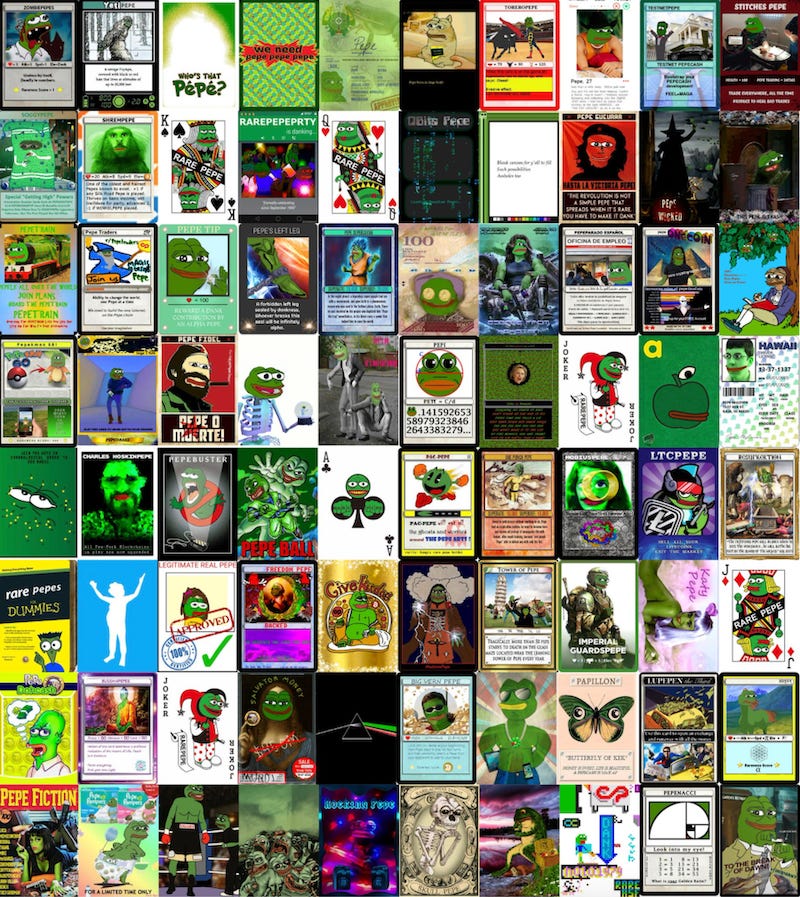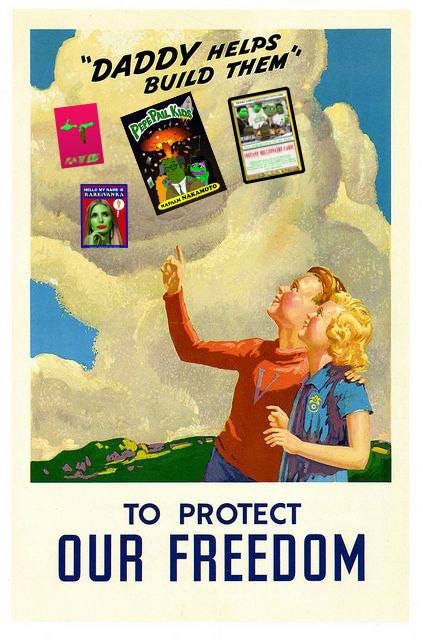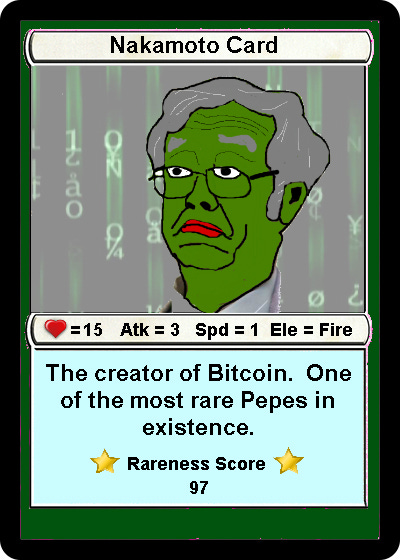🐸 Should you be stacking Pepes?
Why the Rare Pepe Nakamoto Card is the most significant NFT ever created (Part II)
In the first part of our deep-dive into the history of Rare Pepes from Metaversal Fellow, Mr. Fox, we looked at the complex history of Pepe the Frog, first as a comic book character, then as a symbol of right-wing extremism, and finally, as a tool for early crypto artists to express themselves.
In this installment, we’ll unpack Rare Pepes as an investment, and unpack the technical details prospective collectors need to be aware of. But, if you haven’t read Part I, we strongly recommend doing that first.
Right, let’s get straight into it!
What Are Some Of The Other Important Pieces Of Rare Pepe Infrastructure? We’ve spoken previously about where to buy a Rare Pepe, but how about where the Pepe is stored?
Thanks to Joe Looney, the most common application for Rare Pepe storage is actually the Rare Pepe Wallet, a Bitcoin wallet specifically designed to serve the Pepe community. Other wallets do exist — such as Freewallet.io or Counterwallet, but Looney’s Rare Pepe Wallet is undoubtedly the storage place of choice in the Pepe community. Rare Pepe Wallet is ecosystem-native to Pepes, created with all of the organic interactions of the project in mind. It is by far the tool that makes Pepe composability the easiest.
A consistent theme of the Rare Pepe ecosystem is the amount of community goodwill that has gone into building its surrounding world. Many of the important pieces of the Rare Pepe universe were designed entirely for free because the group’s passion for the project — and the fun they had (and are still having) with it — is unrelenting.
The Rare Pepe Directory is another key resource for navigating the world’s first tokenized art project. It is the official list of all 1,774 Rare Pepe cards. If a Pepe isn’t in the directory, it is not certified Rare.
The depth of the collection is astounding and speaks to the cypherpunk beginnings of this memetic movement. Today, it’s rare (no pun intended) to see a new resource built for a community that isn’t listed on a roadmap or used as a means of driving hype in an effort to bolster its floor price. The Rare Pepe Blockchain Project was — and still is — a grassroots endeavor dependent (and thriving) on the decentralized coordination of the proud stewards of Pepe.
Almost all of what’s been built in this world is from the charity and generosity of its supporters, and we truly can’t think of an NFT collection that better encapsulates the values and potential of Web3. It’s part of what makes Rare Pepes such a vital part of NFT history.
Cited by veterans of Web3 culture as the birthplace of the CryptoArt movement — from Matt Kane to Vincent Van Dough — The Nakamoto and the rest of the Rare Pepe ecosystem are invaluable and incomparable.
4. Pepe Persists, The Story Of Fake Rares
Perhaps the most mercurial quality of Pepe, beyond his ability to communicate the thoughts and feelings of so many so acutely, is the meme’s knack for continued evolution.
When Pepe had become consumed by and repurposed for hate, there was no reason to believe he would ever make a comeback. Why would he? There is a never-ending supply of characters, moments, and symbols in the ether of memetic potential. And when The Rare Pepe Scientists closed the Rare Pepe Directory at 1,774 cards, there was no reason to believe that it would continue to expand, or continue to garner attention.
But, in hindsight, unsurprisingly, the story would go on in September of 2021 (after three years of Rare Pepe retirement), when original Rare Pepe artist ScrillaVentura shared the following card in the project’s official Telegram:
The card above is not a real Rare Pepe, it is a fake, and sharing it on Telegram was strictly against the official collection’s rules. Consequently, Scrilla was banned from the chat, and he started his own Telegram for Fake Rares. While his actions were intended to be tongue-in-cheek rather than malicious, the next leg of the Rare Pepe Blockchain Project had started: Fake Rares.
The Fake Rare movement is not so much a continuation of Rare Pepes as much as it is an homage to the legacy of the original 1,774 cards and a fork from then. They are cards with the same spec designs and submission rules, but it is made very clear that they are not part of the original set.
Fake Rares have been an extremely positive force in the Rare Pepe ecosystem, as they have allowed for fun to still be had with the beloved collection. So far, there have been 12 Series of Fake Rares, and there are no signs of slowing.
We would be remiss to dismiss Fake Rares as a mere extension of the Rare Pepe Blockchain Project. In fact, we believe that if it weren’t for the Fake Rare initiative, we likely wouldn’t be talking about Rare Pepes right now.
One could argue it is the Fake Rares that have spurred the revival of intrigue into the original Rare Pepes. We’ve seen a mass influx of the avant-garde Web3 artists of today create their own Fake Rares, in a way publicly acknowledging the historical significance of Rare Pepes and contributing to the discourse around it and it’s key role in crypto art history.
This came to a head in Fake Rares Series 8, a composition of cards curated by none other than possibly the most renowned collector in crypto art, Vincent Van Dough.
If Fake Rares were a film franchise, Series 8 could be considered its Avengers: Endgame. Every single name in the book participated in this initiative. Alpha Centauri Kid, Dmitri Cherniak, Coldie, Deekay Motion, Grant Yun, Killer Acid, JakeTheDegen, Dangiuz, Claire Silver, Seerlight, Jak, Other World, Matt Szczur, Matt Kane, and even Vincent Van Dough himself all created cards for the series… and that’s not even an exhaustive list.
We’ve never seen an amalgamation of artists of this magnitude for any project, and it’s unlikely that we will again. Although we wouldn’t say this collaboration went under the radar, it was only really picked up and understood by those who were paying attention to the Rare Pepe ecosystem. As word travels and more people become aware of the enormous respect the greatest in our space have for Rare Pepes, the more confident we are that we’ll be seeing more and more of Rare Pepes and Fake Rares alike.
Assuming you, like us, accept the importance of the Rare Pepes to crypto art history, the investment thesis is clear.
5. Why Digital Assets Are Important?
As we watch the blossoming of the first generation raised on digital platforms and virtual social connections, we are witnessing the power of digital artifacts in real-time. Almost all of Millennial and Gen Z culture is underwritten by digital worlds. Millennials started off on GameBoys, moved to the Wii and PlayStation, and were the guinea pigs for the wave of the social platforms that would prove to have the staying power to rule the world (first MySpace, then Facebook and Instagram, and eventually Snapchat and TikTok).
Gen Z embraced the applications that give Web2 and Web3 thought leaders and institutions the belief that the metaverse can one day be real — Minecraft and Fortnite. Gen Z doesn’t simply live on the internet, it’s the curator of the medium’s culture, and therefore much of the world’s culture.
But the world is realizing that likes, posts, videos, and memes without ownership are dying models. Thanks to Web3, we are at the beginning of the beginning when it comes to “owning the memes of production.”
It’s reverberated across the halls of Web3 that the period in time when we didn’t own our digital footprint will be a negligible blip in the timeline of our virtual lives. People will look back and be confused as to how it was we even operated this way.
This is why digital assets are important. For the first time in this new paradigm’s history, we have the ability to own, transact, and store culture. And now that our culture is almost entirely controlled by the decisions we make as an online collective, there has never been a more opportune time for us to tangibly produce in this intangible, digital cornucopia.
What’s more, we’re far from the digitized peak of our day-to-day lives. In fact, we’ve only just begun. There still remains a layer of separation between our physical and virtual lives — the machine. We now have some of the biggest entities in the world attempting to close this gap by building various metaverses and other immersive experiences. Facebook thinks it can rebrand as Meta and own this world. Nike thinks it can acquire RTFKT and stake a claim to virtual fashion. In short, big businesses and legacy powerhouses are paying attention.
As more of our lives become digital, the need for — and potential value of — digital assets compounds exponentially. Soon, we’ll move past collectibles and into goods we’ll need to facilitate our basic interactions and access. Degrees, records, connections, voting rights, and potentially the means to prove our very identities.
6. Why The Nakamoto is The Most Important NFT
We believe The Nakamoto is the most important NFT of all. Why? Because The Nakamoto combines three very powerful characteristics:
It’s the most memetic meme of all time
It’s underpinned by Bitcoin, which is itself the start of decentralization via blockchains
It represents the first instance of transact-able culture
Pepe is more than simply a meme. Pepe is the father of all memes as we know them. It was the early uses of “Feels good man” that ignited the world of memes today. And even if you disagree with Pepe’s role as the initiator of memetic culture, it’s hard to contest his fame. Pepe is the most famous, most popular meme of all time.
Pepe is not simply a meme. Pepe is what awakened the world to the power of memes. This explains, in part, why so many people want to get hold of Pepe NFTs — there’s increased demand for memetic aptitude, and tokenized memes are enjoying increased significance.
Pepe, is the base, the color, and the life, of The Nakamoto.
But the Nakamoto gets much, much deeper still.
The second side of The Nakamoto — the non-Pepe side, which all Rare Pepes and Fake Rares have — depicts Satoshi Nakamoto himself. It would be easy to admire this at face value as a cool nod to the anonymous creator of Bitcoin, but this would be overlooking a key point to what makes The Nakamoto brilliant.
Crypto historians will know that the face of Satoshi Nakamoto on the Nakomoto card isn’t actually the founder of Bitcoin (who remains unknown), but instead that of Dorian Nakamoto, who was once incorrectly assumed to be Bitcoin’s founder. Once rumors about who was were dismissed, the conspiracy theory surrounding Dorian Nakamoto died, and the first meme of crypto was born.
Dorian Nakamoto was suddenly everywhere, and it seemed for the first time, the decentralized finance movement had a face. In this way, The Nakamoto is not only the integration of the greatest Web2 meme of all time but the combination of it and the first and greatest meme of Web3. The Nakamoto is a cultural icon at every level.
Bitcoin meme asides, The Nakamoto’s provenance is unrivaled in the world of digital goods. Firstly, it was minted on the first-ever blockchain, the network that has inspired all of the distributed network initiatives we have today. Further, and arguably more importantly, it is the first digital good created in the name of art, minted without conventional financial utility. This is why it has been cited as the birthplace of all crypto art.
The Nakamoto is the first intersection of memes and blockchain. And not just any meme or blockchain for that matter, but the world’s greatest meme and the world’s first blockchain. It represents a turning point in history as the first piece of tokenized culture as a result of this intersection. As the inception of crypto art, the minting of The Nakamoto was a true paradigm shift. Digital culture will forever be divided into the period before The Nakamoto and everything after its creation.
This moment in history must not be understated. It is the collision of the two most powerful digital movements of our time: the memetic culture of the internet which is the single greatest influence on society and culture today, and blockchain technology which enables decentralization of finance, ownership, and value transfer for the first time in human history. We cannot think of two more important things than those.
This is why anyone who cares about meme culture, the history of the internet, or digital art should aim to own The Nakamoto.
7. Why The Nakamoto Is An Attractive Investment
As the digitization of our life continues, and so to the tether between culture and our online lives, The Nakamoto’s significance will only grow. But what other factors do we have to include when considering its attractiveness as an investment?
The supply of only 300 will be music to the ears of current holders and those realistically interested in becoming one. As more of them wind up in “diamond hands” supply will diminish, pushing prices higher.
To this point, we must remember the foundations of the Rare Pepe Blockchain Project. Started by a group of early Bitcoiners who had little care for monetary gain, Pepes were a passion project. And, in case you haven’t connected the two, anybody who was early to Bitcoin is up a pretty penny, and likely doesn’t have much incentive to sell an asset they believe is a grail.
Acquiring a Nakamoto is a beastly process. As a result, it’s almost guaranteed that there have been several Nakamotos removed from the supply forever due to mistakes in the process or lost wallets. Relative to the standard supply of 10,000 we see in the coveted collections on Ethereum, collectors should be licking their lips at the shot of joining an elite group of 300 owners of an incomparable slice of Web3 history.
As both a venture fund and venture studio, we at Metaversal are also attracted by the fact that the Rare Pepe has far fewer champions than projects like CryptoPunks or Bored Ape Yacht Club, which are constantly being publicly supported by thousands of loyalists. We think there is ample room for collectors to make their voices heard and join a movement to make more people aware of the story and magnitude of historically relevant projects that help shape the enthusiasm for NFTs we see today.
Finally, what can be seen as both a pro and con is the barrier to entry. Yes, The Nakamoto is by no means easy to acquire. But we think there is an interesting self-serving bias here. Which is that anybody who does go through the effort of securing a Nakamoto understands the gravity of the asset. We believe this adds even more credit to the theory that this is a strong group of holders. Further, as we’ve seen in recent months and years, these barriers to entry will continue to get lower, growing the sea of potential buyers.
There are only a few risks and costs we think about in terms of an investment in this grail.
8. Accessibility, Friction, and Third-party risk
Although the accessibility of The Nakamoto and other Rare Pepes can be seen as a benefit, we would be remiss not to acknowledge it for what it is: a barrier to entry. Buying and storing Rare Pepes are difficult. That said, we’ll look for this to improve with time as is already happening.
Secondly, the third-party risk of Emblem Vault cannot be overlooked. Emblem Vault does reduce the friction of the Pepe ecosystem dramatically by enabling Ethereum-like interaction, but not without a cost. It is through Emblem Vault that many hold their Nakamotos and Rare Pepes. Even punk6529’s fund does it this way, despite the usual “not your keys, not your crypto” maxim. But, if your Pepe is wrapped through Emblem Vault, the private keys of the card are controlled by the vault. Although the Pepe community is extremely trusting of the team at Emblem Vault, the risk of something going awry when you’re not in control of your assets is always non-zero.
Should you choose to participate in the Rare Pepe ecosystem, we recommend controlling your own Rare Pepe wallet, and acquiring the asset on Bitcoin, despite the added effort this approach demands.
We know this deep dive has been especially deep, so if you’ve made it all the way to the end we salute you. We wanted to give this asset the attention it deserves as arguably the most important digital good in the world. We hope that you enjoyed our first deep dive, that you share it with your friends, and — above all — that you now have a new appreciation for the Rare Pepe Blockchain project.
If you enjoyed this deep dive, please consider sharing it with someone else who might enjoy it too.
This deep dive was put researched and written by Mr. Fox. It was edited by Craig Wilson. We welcome all and any feedback. Join us next week as we get deep into the world of legendary digital artist and crypto art pioneer, XCOPY.







